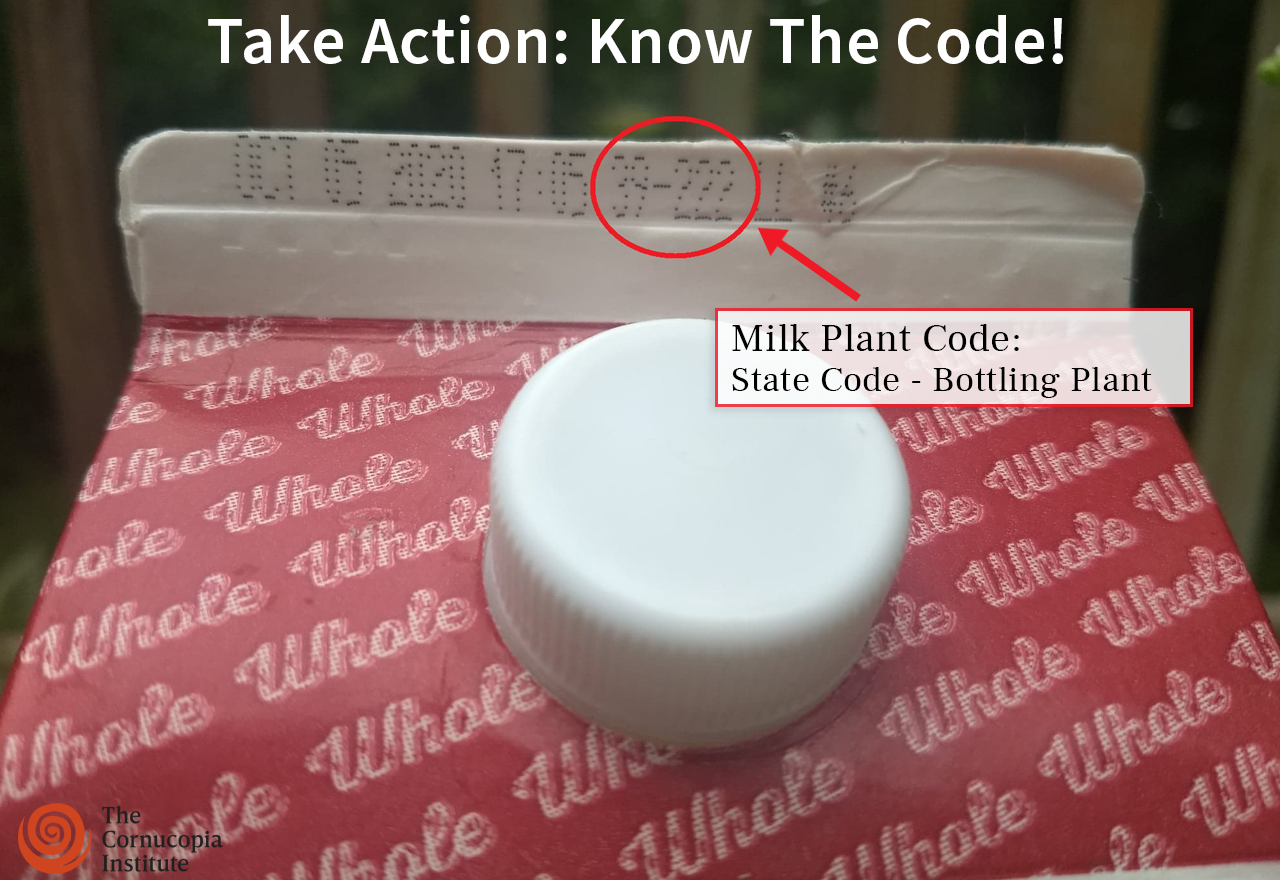What if you had a way to avoid milk from an “organic” dairy feedlot operation? Happily, you may!
It requires the fine print, usually found near the top of the milk carton or on the lids of gallon containers. Those faint numbers, known as the “milk plant code,” give you a glimpse inside a supply chain lacking in transparency. (Read more about milk plant codes and what they reveal at the bottom of this post.)
This tool helps you avoid brands that embrace industrialized practices. The mega-dairies that supply many store brands seemingly flout the organic rules without serious legal consequence. While free from growth hormones, antibiotics, and pesticide residues, factory organic dairy lacks the higher levels of beneficial fats, such as conjugated lineolic acid and omega-3 fatty acids, found in authentic organic milk.
You can help us shape transparency in the marketplace with your personal investigation. Plant codes found on milk containers can give the organic community information about the source of our organic milk.
Send us your plant codes today!
- Please visit co-ops, grocery stores, and big-box retailers (Walmart, Target, Costco, etc.) and write down the plant codes (organic brands only).
Codes are usually printed near the top of the paper container and somewhere on the lids of gallon containers. Sometimes they’re printed right on the label. For more on finding the code, click here.
- Complete this form with the following:
- Store purchased from (such as Safeway, Whole Foods, Target, WalMart, etc.)
- Store city and state
- Organic Milk Brand
- Milk plant code
The information you submit will be used in Cornucopia’s ongoing investigations and help us expose the brands that want to hide their activities from caring consumers that invest in organics for their families, for their health, for the environment, to treat cows more respectfully, and to support the very best organic family farmers.
When you buy authentic organic, you are investing in human health, the soil, plant life, animal health, and clean water. Donate today and help us inform consumers so we can shape our collective future.
Avoid milk from Aurora Organic Dairy
Aurora Organic Dairy is a repeat offender. Aurora’s Platteville, Colorado bottling facility uses the code 08-29 (could appear as 08 29). If your brand of milk is packaged in that facility, it almost certainly comes from a factory organic dairy. You can use Cornucopia’s Organic Dairy Scorecard to find a brand that more closely aligns with your expectations for animal care, environmental impact, and value to human health.
1. Locate the milk plant code on the carton or jug of milk. If the milk plant code is 08-29, that is Aurora’s bottling facility
2. Seek another brand of organic milk, guided by Cornucopia’s Organic Dairy Scorecard.
3. If you cannot avoid factory organic dairy, consider finding a local dairy, guided by Cornucopia’s DIY Certification Guide.
4. Choose industrial organic dairy over industrial conventional dairy (any non-organic dairy at the grocery store).
5. Email us to report how it went.
If you can only find Aurora’s milk in your local market, we suggest you ask the dairy manager to procure another organic brand. Although they may be unable or unwilling to help, your efforts can impact the products they stock over time.
If all of the organic milk at area stores come from poorly rated industrial operations, you may consider looking for a dairy producer near you (try eatwild.com or localharvest.org). Our DIY Certification Guide can help you ask the kinds of questions a certifier would ask if the farm is not certified organic.
What is a Milk Plant Code?
This numerical bit, typed in faint gray numbers somewhere on the milk container, tells you exactly where the milk was processed and packaged.
The first two numbers of the code (which can be followed by a dash or a space) indicate the state where the facility resides. Aurora’s code begins with 08, which indicates it is packaged in Colorado. The numbers after the dash or space are assigned to specific plants within that state.
Use this list to find out where your milk was processed. You may be surprised by how far that milk has traveled to wind up in your breakfast bowl.


